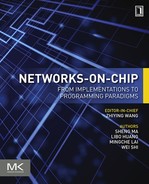Index
Note: Page numbers followed by f indicate figures and t indicate tables.
A
Acknowledgment messages (ACKs) 20
Adaptive communication mechanism (ADCM) 323
RBC table 337
receiver operations 333
RPU 337
sender operations 332
SPU 335–336
B
Balanced, adaptive multicast (BAM) routing 20
DOR 269
Duato's theory 268
evaluation 271
multicast routing algorithm 268
obligatory output ports 268
RPM types 267–268
Bubble flow control (BFC) 21
Bufferless flow control 20–21
Bus mode signal 119
C
Cache-coherent collective communications 20
BAM + Com 276
message combination mechanism 284
NoC multicast routing algorithm 284–285
virtual multicast tree 284–285
Collective communication 294
cache-coherent See (Cache-coherent collective communications)
interconnection layer 5–6
logic implementation layer 6
parallel programming paradigm layer 5
Communication customization architectures control messages 295
message buffer management 296
VBON 296
Content-addressable memory (CAM) 264
D
Dark silicon 6
Deadlock avoidance theory, 358 179
conventional design 218
DAMQ 209
Duato's theory 187
FBFC theory See (Flit bubble flow control (FBFC))
VC reallocation 180
WPF 182–185
Destination-based adaptive routing (DBAR) 19
propagation wires 168–169
router architecture 152f
scalability 169
EVCs See (Escape virtual channels (EVCs))
VC reallocation 180
head-of-line (HoL) blocking 79
VC allocation module 90–91
Dynamic voltage and frequency scaling (DVFS) 32
E
connected routing function 187
deadlock-free algorithm 187
direct and indirect dependency 187
Duato's theory 187
EVC2/AVC2 185–186
extended VC dependency graph 187
network path 187
routing subfunction 187
F
Flit bubble flow control (FBFC) 22
flit reservation 21
fully adaptive routing See (Fully adaptive routing algorithms)
Alg and Alg+WPF 209–211
DAMQ 209
Duato's theory 179–180
EVCs See (Escape virtual channels (EVCs))
fairness effect See (Latency distribution)
hybrid flow controls 209
off-chip network 176
packet length 208–209
performance analysis 203–204
router microarchitecture See (Router microarchitecture)
synthetic traffic See (Synthetic traffic patterns)
VC reallocation 180
WPF 182–185
H
hotspot and transpose patterns 101
memory array 98–99
I
Intel's 80-core Teraflops chip 290
K
L
M
computation/communication-centric method 6–7
parallel programming 5
ME. See MPI engine (ME)
entry 267
multicast packet 263
Message passing interface (MPI), 358 20
applications 307–308
buffered communication 294
Cell Broadband Engine processor 292
communication customization See (Communication customization architectures)
definition 290–291
MPICH 292
MPI/Pro 292
multicast operations 293
multi-FPGA system 292
NAS Parallel Benchmarks (NPB 2.4) suite 344
NoC designs 293–294
optimization 329–330
real traffic pattern See (Real traffic pattern)
rMPI 292
SCC 292–293
STAR-MPI and HP-MPI 291–292
STORM system 292
synchronous communication 294
SystemC-based cycle-level NoC simulator 307
TMD-MPE 291
MPI. See Message passing interface (MPI)
collective communication See (Collective communication)
PPU 297
send and receive operations 298–299
N
Neighbors-on-path (NoP) design 19
Nondeterministic routing 10
O
Oblivious routing algorithm 10
On-chip network (OCN) 29–30
Operand network (OPN) 28–29
P
network size 199
SFP ratio 196
synthetic workloads 192
VC count 199
VC depth 196–197
Power processing element (PPE) 27
PR. See Parameter registers (PR)
Prevention flow control 21
R
RCA. See Regional congestion awareness (RCA)
Receiving buffer credit (RBC) table 337
Receiving policy unit (RPU) 337
Redundant bus method 114–115
congestion propagation network 149–150
in-depth analysis 166–169
small regular region 161–162
synthetic traffic results 156–161
channel dispenser unit 57
speculative router 56
crossbar 15
input units 13
output unit 15
permissible port 189
research 22–23
routing computation 14
switch allocation and traversal 188–189
virtual channel allocator 14
deadlock freedom 10–11
LOCAL 145
nondeterministic routing 10
off-chip networks 144
selection strategy 142–143
synthetic traffic patterns 156
RPU. See Receiving policy unit (RPU)
S
Sending policy unit (SPU) 335–336
low-latency router 55
microarchitecture designs See (Microarchitecture designs)
principles 60
router architecture See (Router architecture)
simulation infrastructures 66
SPU. See Sending policy unit (SPU)
buffer utilization 193–194
evaluation 191
FULLY and PSF 190–191
MPI 307
T
Topology design 17–18
Traffic generation 128
advantages 113–114
Tree-based multicast routing 20
CBS and FBFC 240
methodology 242–243
U
Unicast routing designs 18–19
V
Valiant routing algorithm 9–10
EVC approach 109–110
multicast communications 110
multicast latency 113
NoC design 296
on-chip interconnection networks See (On-chip interconnection networks)
starvation and deadlock avoidance 124
traffic generation 128
unicast message latency 112–113
W
..................Content has been hidden....................
You can't read the all page of ebook, please click here login for view all page.
